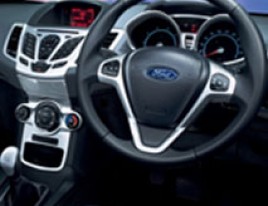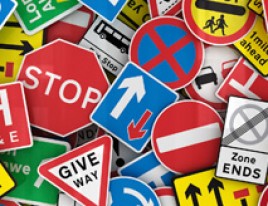
Driving Tutorials | Controls And Instruments
You need to know enough about the controls of a car to be able to operate them property whilst driving.
If you want to or expect to get the best from your car you need to use the controls sympathetically.
Foot Controls
Use the left leg for the clutch only and the right leg for the brake and accelerator
Accelerator
The pedal on the right is the Accelerator, Instructors refer to it as the gas pedal simply because it is quicker to instruct “more gas” than it is to say “press the accelerator down a little further”. It is operated by the right foot and controls the speed of the car. The further down you press it the faster the engine runs which in turn drives the car’s wheels faster. When you ease off the gas pedal the engine runs more slowly and the car slows down. It is a very sensitive pedal; only slight pressure is required to get a result. You need to be able to operate the controls smoothly and it is probably best to rest your heel on the floor and just use the ball of your foot or toes to work the pedal.
Foot Brake
The middle pedal is the foot brake; it is also only operated with your right foot. The foot brake works on all four wheels of the car. Don't stamp on the pedal, squeeze the pedal progressively until the car comes to a stop. as it does ease off the pedal to avoid a jolt. When you touch the brake, brake lights come on on the back of the car informing other road users behind you that you are slowing down.
Clutch
The pedal on the left is the clutch and is operated with the left foot only. This pedal is used to move the car, change the gears and to stop the car without stalling the engine. It is used to move the car away or to change gear and to stop the car without stalling the engine. Imagine you are a passenger in the car and the driver stops at a red light, the engine keeps running because the driver puts the clutch down as the car comes to a stop and in doing so disconnects the engine from the wheels. The clutch allows the wheels of the car to stop turning without the engine cutting out. As the driver moves away again the driver raises the clutch slowly enabling the engine to drive the wheels.
Gears
The gear lever is always operated together with the clutch. The gears are used to match the speed of the engine to the speed of the car. As the car picks up speed you need to select a higher gear. Each gear has a limited amount of power. The higher the gear the less the power but greater the speed. Imagine having to push your car out of the way because it had run out of petrol, it is heavy but as soon as you have some momentum it takes far less effort to keep the car rolling. In order to get the car moving you need the gear with the most power which is first gear. Once the car is moving you can change up one or more gears once you are at the required speed. Slowing down is the same you need to match the gear to the speed of the car so that when you come to accelerate again the car has the right amount of power to go.
It is not always necessary to go up and down through the gears in order. It is often better to skip a gear in order to match the speed of the engine to the road speed. This means that if you are in fourth or fifth gear and need to stop at a red light, you can brake to stop and then select the first gear to go.
You need to practice moving the gear lever into the various positions because when you are driving you should keep your eyes on the road ahead when changing gear.
Steering
Try not to look down at the end of the bonnet because this can affect your steering. Looking well ahead helps to keep the car in a straight line, so keep your head up and your eyes high. Keep both hands on the steering wheel. Position them at a ten to two or a quarter to three position. Remember, it is normally only the front wheels that steer. When you turn left the back wheels may cut in and will mount the kerb if you steer too early. When turning right you will cut the corner if you steer too early.
Parking Brake
The parking brake is used to secure the car once it has stopped. Normally it only works on the car's back brakes. To apply it, you push the button in and pull it up. To release the parking brake, pull it up slightly and push the button in then drop the lever onto the floor.
Ancillary Controls
You need to familiarise yourself with all the ancillary controls in the car. The indicators can be found on either the left or the right of the steering wheel. Know where your lights are and how to operate the windscreen wipers, demisters and heaters.
Warning Lights
When you're ready to start the car, turn the key to ignition on and check to see if all the dash lights come on and then go off, except parking brake, oil, water, battery and engine management. All other lights should go off without flashing. When you start the car all lights should be off except the parking brake without any lights flashing.






